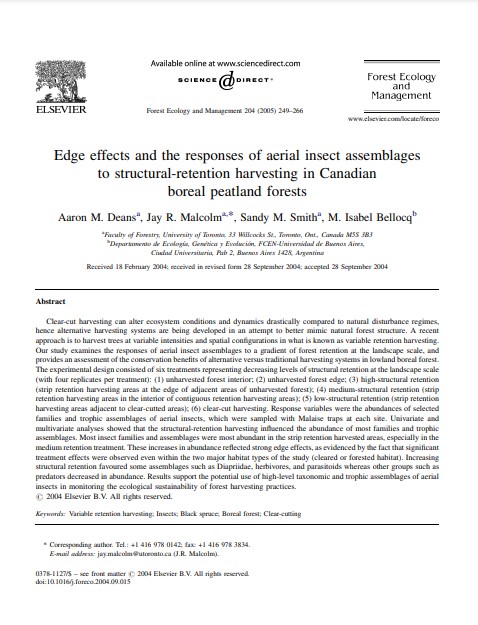Edge Effects and the Responses of Aerial Insect Assemblages to Structural-Retention Harvesting in Canadian Boreal Peatland Forests
Bosque Modelo:
Lake Abitibi
Temática:
Gestión forestal
Tipo de documento:
Artículo científico
Resumen
Clear-cut harvesting can alter ecosystem conditions and dynamics drastically compared to natural disturbance regimes, hence alternative harvesting systems are being developed in an attempt to better mimic natural forest structure. A recent approach is to harvest trees at variable intensities and spatial configurations in what is known as variable retention harvesting. Our study examines the responses of aerial insect assemblages to a gradient of forest retention at the landscape scale, and provides an assessment of the conservation benefits of alternative versus traditional harvesting systems in lowland boreal forest. The experimental design consisted of six treatments representing decreasing levels of structural retention at the landscape scale (with four replicates per treatment): (1) unharvested forest interior; (2) unharvested forest edge; (3) high-structural retention (strip retention harvesting areas at the edge of adjacent areas of unharvested forest); (4) medium-structural retention (strip retention harvesting areas in the interior of contiguous retention harvesting areas); (5) low-structural retention (strip retention harvesting areas adjacent to clear-cutted areas); (6) clear-cut harvesting. Response variables were the abundances of selected families and trophic assemblages of aerial insects, which were sampled with Malaise traps at each site. Univariate and multivariate analyses showed that the structural-retention harvesting influenced the abundance of most families and trophic assemblages. Most insect families and assemblages were most abundant in the strip retention harvested areas, especially in the medium retention treatment. These increases in abundance reflected strong edge effects, as evidenced by the fact that significant treatment effects were observed even within the two major habitat types of the study (cleared or forested habitat). Increasing structural retention favoured some assemblages such as Diapriidae, herbivores, and parasitoids whereas other groups such as predators decreased in abundance. Results support the potential use of high-level taxonomic and trophic assemblages of aerial insects in monitoring the ecological sustainability of forest harvesting practices.
Información Bibliográfica
Autor:
Deans, A, J Malcolm, S Smith, M Bellocq.
Revista:
Forest Ecology and Management
Año:
2005
N°:
-
País :
Canadá
Páginas:
249 - 266
Volumen:
204
Idioma:
Ingles
Palabras claves
Variable retention harvesting; Insects; Black spruce; Boreal forest; Clear-cutting





